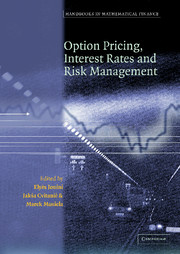Book contents
- Frontmatter
- Contents
- List of Contributors
- Introduction
- Part one Option Pricing: Theory and Practice
- 1 Arbitrage Theory
- 2 Market Models with Frictions: Arbitrage and Pricing Issues
- 3 American Options: Symmetry Properties
- 4 Purely Discontinuous Asset Price Processes
- 5 Latent Variable Models for Stochastic Discount Factors
- 6 Monte Carlo Methods for Security Pricing
- Part two Interest Rate Modeling
- Part three Risk Management and Hedging
- Part four Utility Maximization
2 - Market Models with Frictions: Arbitrage and Pricing Issues
from Part one - Option Pricing: Theory and Practice
Published online by Cambridge University Press: 29 January 2010
- Frontmatter
- Contents
- List of Contributors
- Introduction
- Part one Option Pricing: Theory and Practice
- 1 Arbitrage Theory
- 2 Market Models with Frictions: Arbitrage and Pricing Issues
- 3 American Options: Symmetry Properties
- 4 Purely Discontinuous Asset Price Processes
- 5 Latent Variable Models for Stochastic Discount Factors
- 6 Monte Carlo Methods for Security Pricing
- Part two Interest Rate Modeling
- Part three Risk Management and Hedging
- Part four Utility Maximization
Summary
Introduction
The Fundamental Theorem of Asset Pricing, which originates in the Arrow-Debreu model (Debreu (1959)) and is further formalized in (among others) Harrison and Kreps (1979), Kreps (1981), Harrison and Pliska (1981), Duffie and Huang (1986), Dybvig and Ross (1987), Dalang, Morton and Willinger (1989), Back and Pliska (1990), Stricker (1990), Delbaen (1992), Lakner (1993) and Delbaen and Schachermayer (1994, 1998), asserts that the absence of free lunch in a frictionless (and complete) securities market model is equivalent to the existence of an equivalent martingale measure for the normalized securities price processes. The only arbitrage free and viable pricing rule on the set of contingent claims, which is a linear space, is then equal to the expected value with respect to the unique equivalent martingale measure.
In this chapter, we study some foundational issues in the theory of asset pricing in general models with flows as well as in securities market models with frictions. We consider financial models, where any investment opportunity is described by the cash flow that it generates. For instance, in such models, the investment opportunity, which consists, in a perfect financial model, of buying at time t1 one unit of a risky asset, whose price process is given by (St)t≥0, and selling at time t2 with t1 ≤ t2 the unit bought, is described by the process (Φt)t≥0 which is null outside {t1, t2} and which satisfies Φt1 = -St1 and Φt2 = St2.
Information
- Type
- Chapter
- Information
- Handbooks in Mathematical FinanceOption Pricing, Interest Rates and Risk Management, pp. 43 - 66Publisher: Cambridge University PressPrint publication year: 2001
